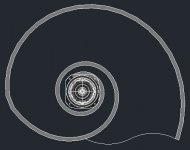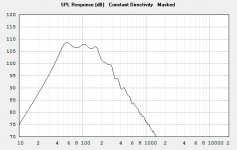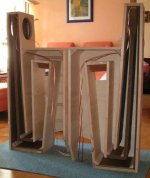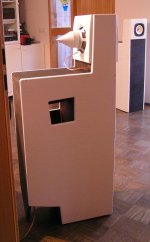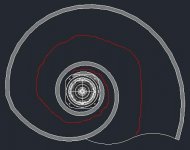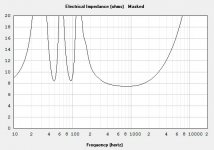Just about finished a design for my first speaker build but would like to run it past the peeps here for comments. I can't afford the time or money to build something which I then scrap because I can't stand the sound, so if anyone can point out improvements or forseable problems that'd be appreciated.
I've based the design around the FE166En mainly because of the extension at both ends. I'm looking for speaker that can handle ANY music I throw at them, from drum+bass to Vivaldi, Chilli Peppers to new age didj. I've spent ages tweaking in Hornresp and seem to have come up with a reasonable response but I'm unsure how accurate the program is for what I'm asking it to simulate, this is not a simple horn.
So:
Camber ~ 8l, I know this is big but I can fill with stuff if it proves too much in practice
Horn mouth - 80cm2 giving a compression ratio of 1.66 starting a series of horn segments looking much like a space rocket when straight 🙂 Then curled up into a kind of snail shell arrangement.
I have attached the Hornresp parameters, SPL response and a cad image of the design in a 300mm deep cabinet. I'm not afraid of a little woodwork and have a fully equipped workshop at my disposal hence the less conventional enclosure. I am however limited on space for these by room geometry / WAF. If anyone has any ideas to extend the bass without increasing cab volume I'm all ears. I was originally aiming for about 10Hz more but don't seem to be able to achieve that without a cab that's under 200l, and I don't even know if it's realistic with this driver. The current design is around 150l. I know the schematic doesn't show the final segment but that will be formed by a bend forward into the room and corner / alcove placement.
Any comments greatly appreciated😀
I've based the design around the FE166En mainly because of the extension at both ends. I'm looking for speaker that can handle ANY music I throw at them, from drum+bass to Vivaldi, Chilli Peppers to new age didj. I've spent ages tweaking in Hornresp and seem to have come up with a reasonable response but I'm unsure how accurate the program is for what I'm asking it to simulate, this is not a simple horn.
So:
Camber ~ 8l, I know this is big but I can fill with stuff if it proves too much in practice
Horn mouth - 80cm2 giving a compression ratio of 1.66 starting a series of horn segments looking much like a space rocket when straight 🙂 Then curled up into a kind of snail shell arrangement.
I have attached the Hornresp parameters, SPL response and a cad image of the design in a 300mm deep cabinet. I'm not afraid of a little woodwork and have a fully equipped workshop at my disposal hence the less conventional enclosure. I am however limited on space for these by room geometry / WAF. If anyone has any ideas to extend the bass without increasing cab volume I'm all ears. I was originally aiming for about 10Hz more but don't seem to be able to achieve that without a cab that's under 200l, and I don't even know if it's realistic with this driver. The current design is around 150l. I know the schematic doesn't show the final segment but that will be formed by a bend forward into the room and corner / alcove placement.
Any comments greatly appreciated😀
Attachments
Stone T
Hello,
this design has a very short way and a long, i dont think that you
can simulat this exactly, to dam the presschamber makes it larger,
for that size i would prefer my double horn POSAUNE much more bass
less membran movement better soundstage:
Hello,
this design has a very short way and a long, i dont think that you
can simulat this exactly, to dam the presschamber makes it larger,
for that size i would prefer my double horn POSAUNE much more bass
less membran movement better soundstage:
Attachments
Thanks Horst. I've seen that design many times, very interesting. I should imagine it sounds fantastic. However, unless I'm mistaken it uses 2 drivers per cabinet, which would near double the cost for me. Also they would not fit where I am allowed to put the by my better half, she would prefer something highly 'aesthetic'.
I'm afraid I dont understand 'to dam the presschamber makes it larger' but the horn length as shown is a little over 2m and has no very short way as you say.

I'm afraid I dont understand 'to dam the presschamber makes it larger' but the horn length as shown is a little over 2m and has no very short way as you say.
than you don´t understand,
the snail folding has one short way and one long,
what gives an aesthetic looking if it does not sound.
Dam material enlarge the volume, 8 L without dam material
will sound bad, do you simulate it?
For the Posaune you need only a very cheap back driver.
the snail folding has one short way and one long,
what gives an aesthetic looking if it does not sound.
Dam material enlarge the volume, 8 L without dam material
will sound bad, do you simulate it?
For the Posaune you need only a very cheap back driver.
Last edited:
😕 Eh? As far as I can see, it's one horn, folded / turned into a spiral. Axial horn length is generally taken up the centre of the expansion (as roughly hand-draw in the attached), so I'm not sure where the one short, one long comes from. Am I missing a 2nd horn here?
Attachments
Last edited:
I thought it was one horn too. 😕 apparently hm knows my design better....
Horst -"dam material"? Do you mean stuffing? Why do you think the 8 l chamber will sound bad? Too much excursion? Anyway as I said- the volume can be reduced post construction fairly easily so I'd rather start too big than too small. The potential for using a cheaper back (bass) driver for your design is very interesting and could be used for many applications. What kind of driver would you suggest? It would presumably still need a suitable Q for horn loading? Also - how are they wired? series would seriously affect the performance of fostex while parrallel would reduce impedance. these speakers will be driven by a ~8W/channel Class A P/P tube amp requiring as high impedance and high efficiency as possible. Your Posaune is very nice and your design principles inspiring, but not for my application.
One thing I'm wondering is how low to go? Most BR designs seem to reach 50Hz but if I'm aiming not to use a sub is the response shown adiquate? I suspect not...
Horst -"dam material"? Do you mean stuffing? Why do you think the 8 l chamber will sound bad? Too much excursion? Anyway as I said- the volume can be reduced post construction fairly easily so I'd rather start too big than too small. The potential for using a cheaper back (bass) driver for your design is very interesting and could be used for many applications. What kind of driver would you suggest? It would presumably still need a suitable Q for horn loading? Also - how are they wired? series would seriously affect the performance of fostex while parrallel would reduce impedance. these speakers will be driven by a ~8W/channel Class A P/P tube amp requiring as high impedance and high efficiency as possible. Your Posaune is very nice and your design principles inspiring, but not for my application.
One thing I'm wondering is how low to go? Most BR designs seem to reach 50Hz but if I'm aiming not to use a sub is the response shown adiquate? I suspect not...
Last edited:
stoneT
look your pic, the left line is much shorter as the right.
simu your imp, IMHO not good for a tube.
look and read my double horns, much more bass as a single horn,
much better imp. For the Posaune you can take a lot of drivers,
SPH 165 Monacor, it is a bipol, drivers parallel.
But thats not the point, built yours and show us the measured result please.
"Why do you think the 8 l chamber will sound bad? "
experience
look your pic, the left line is much shorter as the right.
simu your imp, IMHO not good for a tube.
look and read my double horns, much more bass as a single horn,
much better imp. For the Posaune you can take a lot of drivers,
SPH 165 Monacor, it is a bipol, drivers parallel.
But thats not the point, built yours and show us the measured result please.
"Why do you think the 8 l chamber will sound bad? "
experience
Last edited:
What left & right line? There's only one horn, not two, & axial horn length is generally taken up the centreline.
A larger rear chamber puts less preasure on the back of the driver and therefor gives less damping and flabby uncontrolled bass, adding stuffing will make this worse not better. Check the impulse response in hornresp.
Last edited:
scotti,
the line left and right of the axial line. thats because it is a snail,
do you get it now?
the line left and right of the axial line. thats because it is a snail,
do you get it now?
I was wondering about the differing lengths of the path edges but figured-
A) the effect would probably only be significant if the width of the path was a significant proportion of the propogated wavelength. and if this is wrong then-
B) the result is one side being a bit shorter and the other a bit longer, average length is the same and the effect may only be to spread the resonance spikes (lowering the Q of the cabinet?)
I couldn't find any info on your impedances hm but I cant see how two drivers could be better than one unless they are in series.
A) the effect would probably only be significant if the width of the path was a significant proportion of the propogated wavelength. and if this is wrong then-
B) the result is one side being a bit shorter and the other a bit longer, average length is the same and the effect may only be to spread the resonance spikes (lowering the Q of the cabinet?)
I couldn't find any info on your impedances hm but I cant see how two drivers could be better than one unless they are in series.
stoneT
more to point out my point of view i can´t do, built it and test it.
my mesurements of double horns are here:
saxmess
trommess
kornettmess
rdhmess
physics all the same
except this, but here best shown:
fanfaremess
more to point out my point of view i can´t do, built it and test it.
my mesurements of double horns are here:
saxmess
trommess
kornettmess
rdhmess
physics all the same
except this, but here best shown:
fanfaremess
There's nothing to get. The inner face of any bent or folded pipe will be physically shorter than the outer face. That's not exactly news given that we live in a three dimensional world. However, for practical purposes the axial length of the horn is taken up the centreline. Any negative effects will be minimal for a box of this size in comparison to other matters, so I really wouldn't loose much sleep over it.
Series or parallel wiring, you've got +6dB dynamic range, or 1/2 the displacement for a given SPL.
Series or parallel wiring, you've got +6dB dynamic range, or 1/2 the displacement for a given SPL.
Last edited:
scotti,
a snail folding has the worse (longest) difference of the short and long way,
my double horns won´t work in series, tested by Visaton and my own,
you will delete the bass.
a snail folding has the worse (longest) difference of the short and long way,
my double horns won´t work in series, tested by Visaton and my own,
you will delete the bass.
Yes, that is primary school level geometry. However, for a box this size & of this tuning, the potential negative effects thereof will be relatively small compared to other matters.
I wasn't refering to your designs, merely stating the basic principle that wiring two identical drivers in series or parallel gives you another 6dB of dynamic range.
I wasn't refering to your designs, merely stating the basic principle that wiring two identical drivers in series or parallel gives you another 6dB of dynamic range.
Last edited:
Ah! I was hoping someone might expand on these 'other matters'🙂Any negative effects will be minimal for a box of this size in comparison to other matters
The coiling of the horn was a slight concern of mine but less so than things like
-the aspect ratio of the mouth (300x26 mm)
-the narrow bandwidth of the horn effect integrating with the rest of the driver's response.
-the physical chalange of creating a stiff enough curved path (current thinking is kerf cut mdf for the curve with voids filled during construction with pva, ply for the faces.
And hopefully a host of issues I hadn't even thought of.
Would I be better off just building a BR for instance? I need fairly high efficiency, I want lots of bass, I don't have much room. Is this a 'pipe dream'?😉
Hm- all your impedance plots seem to show pretty low impedance, as I expected. My amp would be distorting at any reasonable level. The impedance plots from hornresp I have show minimum of about 7.5 Ohms and thats at 900Hz, nothing to do with the horn action.
misunderstanding,
show us the Imp of your horn below 300 Hz, that i pointed out,
look the subfanfare real single imps and the sum, or the Kornett real imp and the single simu and compair.
what flare rate do you use?
show us the Imp of your horn below 300 Hz, that i pointed out,
look the subfanfare real single imps and the sum, or the Kornett real imp and the single simu and compair.
what flare rate do you use?
OK. "Imp"? Electrical impedance, Acoustical impedance or Impulse response?
Anyway, as I've said, your horns are lovely but not for me in this situation. If you think I have a problem with my design please outline it without a comparison to your own designs clouding the matter.
Flare rate is 73Hz for 80cm - 11Hz for 100cm - 76Hz for 25cm (all approximate)
Electrical impedance of design attached:
Anyway, as I've said, your horns are lovely but not for me in this situation. If you think I have a problem with my design please outline it without a comparison to your own designs clouding the matter.
Flare rate is 73Hz for 80cm - 11Hz for 100cm - 76Hz for 25cm (all approximate)
Electrical impedance of design attached:
Attachments
Hello??
ln (AM/AH)/l = k ,formula flarerate, am=hornmouth, ah=horn throat, l=length
and you must know the blind and real part of a horn to estimate how low it would play.
And you think this will work well with a tube?
Whow.
ln (AM/AH)/l = k ,formula flarerate, am=hornmouth, ah=horn throat, l=length
and you must know the blind and real part of a horn to estimate how low it would play.
And you think this will work well with a tube?
Whow.
- Status
- Not open for further replies.
- Home
- Loudspeakers
- Full Range
- Snail horns for FE166en?
